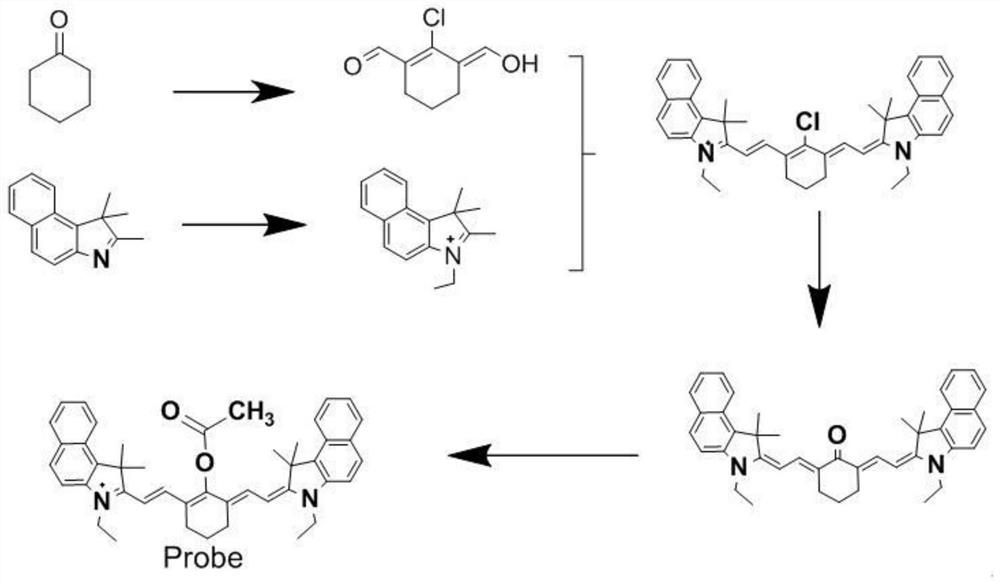Preparation method and application of a ratiometric fluorescent probe for detecting hydrazine
A technology of fluorescent probes and fluorescent molecular probes, which is applied in the field of analytical chemistry, can solve the problems of limited fluorescent probes for hydrazine detection, and achieve the effect of improving detection accuracy
- Summary
- Abstract
- Description
- Claims
- Application Information
AI Technical Summary
Problems solved by technology
Method used
Image
Examples
Embodiment 1
[0055] Example 1: Preparation of ratiometric fluorescent molecular probes
[0056] (1) Dissolve 40mL of anhydrous N,N-dimethylformamide in 40mL of dichloromethane, pour into a jacketed bottle, cool at -10°C and stir for 20 min to obtain a mixed solution 1. Dissolve 37mL of phosphorus oxychloride in 35mL of dichloromethane, mix evenly, pour into the constant pressure funnel, slowly drop into the mixed solution 1, and keep stirring with a magnetic stirrer; after the dropwise addition, add 10g of cyclohexanone Slowly add the powder into the jacketed bottle, return to room temperature when the solution turns bright yellow, then slowly heat to 40°C, and heat to reflux for 3h; Extraction, rotary evaporation to obtain compound 1;
[0057] (2) Add 50ml of benzindole and 50mL of iodoethane into a 500mL three-neck flask, add 200mL of acetonitrile, heat and reflux for 24 hours; cool to room temperature and filter, filter the precipitate and place it in a beaker after being washed with p...
Embodiment 2
[0067] Implementation Example 2: The ratiometric fluorescent molecular probe prepared in Example 1 quantitatively analyzes hydrazine in biological samples: detection of hydrazine content in water samples
[0068] 1) Prepare the solution
[0069] Probe stock solution: Accurately weigh the ratiometric fluorescent molecular probe for detecting hydrazine and dissolve it in acetate buffer and DMSO to prepare a probe stock solution with a concentration of 50 μM; the pH of the acetate buffer is 4.5, and the concentration 10mM; the volume ratio of acetate buffer and DMSO is 1:9;
[0070] Hydrazine stock solution: Accurately weigh 0.00032g of hydrazine and dissolve it in 10mL of deionized water to prepare a hydrazine stock solution with a concentration of 1000μM;
[0071] 2) Establish the linear equation of water sample-hydrazine standard
[0072] Dilute the hydrazine stock solution prepared in step 1) with distilled water to obtain a hydrazine standard solution with a gradient conce...
Embodiment 3
[0076] Implementation example 3: detection of hydrazine in liver cancer cells, the method is: put the liver cancer cells into DMEM medium and cultivate them for 24 hours, and wait until the inoculum amount of liver cancer cells in the medium is 2×10 7 ~9×10 7 Each / mL, then add the ratiometric fluorescent molecular probe for detecting hydrazine, the probe concentration is 5 μM, add 0 μM, 20 μM, 40 μM, 60 μM, 80 μM, 100 μM N 2 h 4, according to the measured fluorescence emission of the fluorescent probe, different excitation and emission wavelengths are selected, and the fluorescence image of the cell is obtained on the confocal laser scanning microscope. The fluorescence intensity at the position increases significantly, and it can be judged that the probe can detect hydrazine in living cells. (red channel 700-800 nm (λex=635nm), green channel 600-700 nm (λex=559 nm)).
[0077] Figure 5 a- Figure 5 e are the fluorescence collection windows for the red channel a) : the re...
PUM
 Login to View More
Login to View More Abstract
Description
Claims
Application Information
 Login to View More
Login to View More - R&D
- Intellectual Property
- Life Sciences
- Materials
- Tech Scout
- Unparalleled Data Quality
- Higher Quality Content
- 60% Fewer Hallucinations
Browse by: Latest US Patents, China's latest patents, Technical Efficacy Thesaurus, Application Domain, Technology Topic, Popular Technical Reports.
© 2025 PatSnap. All rights reserved.Legal|Privacy policy|Modern Slavery Act Transparency Statement|Sitemap|About US| Contact US: help@patsnap.com



